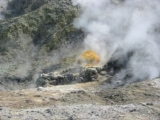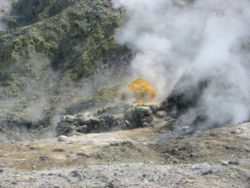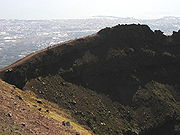
Campanian volcanic arc
Encyclopedia


Volcanic arc
A volcanic arc is a chain of volcanoes positioned in an arc shape as seen from above. Offshore volcanoes form islands, resulting in a volcanic island arc. Generally they result from the subduction of an oceanic tectonic plate under another tectonic plate, and often parallel an oceanic trench...
that consists of a number of active, dormant, and extinct volcanoes in the Campania
Campania
Campania is a region in southern Italy. The region has a population of around 5.8 million people, making it the second-most-populous region of Italy; its total area of 13,590 km² makes it the most densely populated region in the country...
region of Italy
Italy
Italy , officially the Italian Republic languages]] under the European Charter for Regional or Minority Languages. In each of these, Italy's official name is as follows:;;;;;;;;), is a unitary parliamentary republic in South-Central Europe. To the north it borders France, Switzerland, Austria and...
. The Campanian volcanic arc centers on the bay of Naples
Naples
Naples is a city in Southern Italy, situated on the country's west coast by the Gulf of Naples. Lying between two notable volcanic regions, Mount Vesuvius and the Phlegraean Fields, it is the capital of the region of Campania and of the province of Naples...
and includes:
- Mount VesuviusMount VesuviusMount Vesuvius is a stratovolcano in the Gulf of Naples, Italy, about east of Naples and a short distance from the shore. It is the only volcano on the European mainland to have erupted within the last hundred years, although it is not currently erupting...
: an active volcano that last erupted in 1944. - Campi FlegreiCampi FlegreiThe Phlegraean Fields, also known as Campi Flegrei, , is a large wide caldera situated to the west of Naples, Italy. It was declared a regional park in 2003. Lying mostly underwater, the area comprises 24 craters and volcanic edifices. Hydrothermal activity can be observed at Lucrino, Agnano and...
: a huge, ancient calderaCalderaA caldera is a cauldron-like volcanic feature usually formed by the collapse of land following a volcanic eruption, such as the one at Yellowstone National Park in the US. They are sometimes confused with volcanic craters...
containing the western area of Naples. The area is a collection of numerous extinct craters that are evidence of ancient eruptions; however, also included in this area is SolfataraSolfatara (volcano)Solfatara is a shallow volcanic crater at Pozzuoli, near Naples, part of the Campi Flegrei volcanic area. It is a dormant volcano, which still emits jets of steam with sulphurous fumes. The name comes from the Latin, Sulpha terra, "land of sulphur", or "sulfur earth"...
, a shallow volcanic crater still emitting jets of sulfur fumes and, thus, still active. - Mount EpomeoMount EpomeoMount Epomeo is the highest mountain on the volcanic island of Ischia, in the Gulf of Naples, Italy. Epomeo is believed to be a volcanic horst....
: 20 kilometres west of Naples on the island of IschiaIschiaIschia is a volcanic island in the Tyrrhenian Sea. It lies at the northern end of the Gulf of Naples, about 30 km from the city of Naples. It is the largest of the Phlegrean Islands. Roughly trapezoidal in shape, it measures around 10 km east to west and 7 km north to south and has...
, it last erupted in 1302. - Palinuro, Vavilev, MarsiliMarsiliMarsili is a large undersea volcano in the Tyrrhenian Sea, about south of Naples. The seamount is about 3,000 meters tall; its peak and crater are about 450 meters below the sea surface...
, and Magnaghi: undersea extinct or dormant volcanoes south of Vesuvius. The last three were discovered in the 1950s and bear the names of the geologists who discovered them. Palinuro was known earlier. At present, there is some concern about the state of "dormancy" of Marsili, which is 3,000 meters high with the cone reaching to 500 meters from the surface of the water. Satellite cones of recent origin have been detected on Marsili.
"Campanian volcanic arc" is somewhat a term of convenience, since the area is part of the same large area of intense volcanic and seismic activity that includes, further to the south, the active island volcanoes of Stromboli
Stromboli
Stromboli is a small island in the Tyrrhenian Sea, off the north coast of Sicily, containing one of the three active volcanoes in Italy. It is one of the eight Aeolian Islands, a volcanic arc north of Sicily. This name is a corruption of the Ancient Greek name Strongulē which was given to it...
, and Vulcano
Vulcano
thumb| The Gran Cratere. A sense of scale is provided by the tourist visible near the centre of the crater.thumb|right|250px|View of Vulcano from the island of Lipari. The green islet centre left is Vulcanello, which is connected to Vulcano by an isthmus...
off the north coast of Sicily
Sicily
Sicily is a region of Italy, and is the largest island in the Mediterranean Sea. Along with the surrounding minor islands, it constitutes an autonomous region of Italy, the Regione Autonoma Siciliana Sicily has a rich and unique culture, especially with regard to the arts, music, literature,...
and even the largest active volcano in Europe, Mt. Etna, on Sicily itself.

